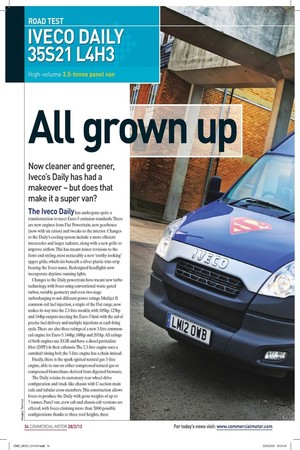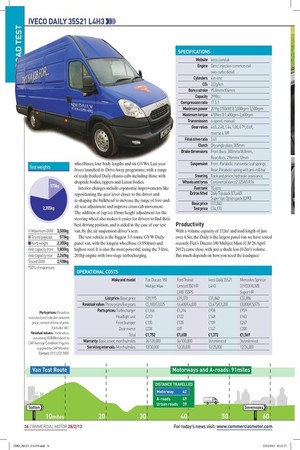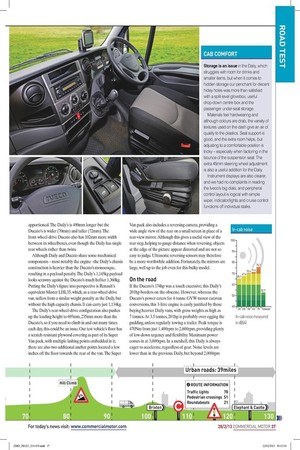ALL grown
Page 25

Page 27

Page 28

Page 29

Page 30

If you've noticed an error in this article please click here to report it so we can fix it.
Now cleaner and greener, Iveco's Daily has had a makeover - but does that make it a super van?
The Iveco Daily has undergone quite a transformation to meet Euro-5 emission standards. There are new engines from Fiat Powertrain, new gearboxes (now with six ratios) and tweaks to the interior. Changes to the Daily's cooling system include a more efficient intercooler and larger radiator, along with a new grille to improve airflow. This has meant minor revisions to the front-end styling, most noticeably a new 'toothy-looking' upper grille, which sits beneath a silver plastic trim strip bearing the Iveco name. Redesigned headlights now incorporate daytime running lights.
Changes to the Daily powertrain have meant new turbo technology, with Iveco using conventional waste-gated turbos, variable geometry and even two-stage turbocharging to suit different power ratings. Multijet II common-rail fuel injection, a staple of the Fiat range, now makes its way into the 2.3-litre models, with 105hp, 125hp and 144hp outputs meeting the Euro-5 limit with the aid of precise fuel delivery and multiple injections at each firing cycle. There are also three ratings of a new 3-litre commonrail engine for Euro-5: 144hp, 168hp and 201hp. All ratings of both engines use EGR and have a diesel particulate filter (DPF) in their exhausts. The 2.3-litre engine uses a camshaft timing belt; the 3-litre engine has a chain instead.
Finally, there is the spark-ignited natural gas 3-litre engine, able to run on either compressed natural gas or compressed biomethane derived from digested biowaste.
The Daily retains its customary rear-wheel-drive configuration and truck-like chassis with C-section main rails and tubular cross-members. This construction allows Iveco to produce the Daily with gross weights of up to 7 tonnes. Panel van, crew cab and chassis cab versions are offered, with Iveco claiming more than 7,000 possible configurations thanks to three roof heights, three wheelbases, four body lengths and six GVVVs. Last year Iveco launched its DriveAway programme, with a range of ready-bodied Daily chassis cabs including those with dropside bodies, tippers and Luton bodies.
Interior changes include ergonomic improvements like repositioning the gear lever closer to the driver and re-shaping the bulkhead to increase the range of fore and aft seat adjustment and improve cross-cab movement. The addition of (up to) 45mm height adjustment for the steering wheel also makes it easier for drivers to find their best driving position, and is aided in the case of our test van, by the air suspension driver's seat.
The test vehicle is the biggest 3.5-tonne GVVV Daily panel van, with the longest wheelbase (3,950mm) and highest roof. It is also the most powerful, using the 3-litre, 201hp engine with two-stage turbocharging.
Productivity With a volume capacity of 17.2m3 and load length of just over 4.5m, the Daily is the largest panel van we have tested recently. Fiat's Ducato 180 Multijet Maxi (CM 26 April 2012) came close, with just a shade less (0.2m3) volume. But much depends on how you need the loadspace apportioned. The Daily's is 490mm longer but the Ducato's is wider (70mm) and taller (72mm). The front-wheel-drive Ducat° also has 102mm more width between its wheelboxes, even though the Daily has single rear wheels rather than twins.
Although Daily and Ducat° share some mechanical components — most notably the engine —the Daily's chassis construction is heavier than the Ducato's monocoque, resulting in a payload penalty. The Daily's 1,145kg payload looks scrawny against the Ducato's much heftier 1,360kg. Putting the Daily's figure into perspective is Renault's equivalent Master LIAL35, which, as a rear-wheel-drive van, suffers from a similar weight penalty as the Daily, but without the high-capacity chassis. It can carry just 1,134kg.
The Daily's rear-wheel-drive configuration also pushes up the loading height to 695mm, 235mm more than the Ducato's, so if you need to climb in and out many times each day, this could be an issue. Our test vehicle's floor has a scratch-resistant plywood covering as part of its Super Van pack, with multiple lashing points embedded in it; there are also two additional anchor points located a few inches off the floor towards the rear of the van. The Super Van pack also includes a reversing camera, providing a wide angle view of the rear on a small screen in place of a rear-view mirror. Although this gives a useful view of the rear step, helping to gauge distance when reversing, objects at the edge of the picture appear distorted and are not so easy to judge. Ultrasonic reversing sensors may therefore be a more worthwhile addition. Fortunately, the mirrors are large, well up to the job even for this bulky model.
On the road If the Ducato's 174hp was a touch excessive; this Daily's 201hp borders on the obscene. However, whereas the Ducato's power caters for 4-tonne GVVV motor caravan conversions, this 3-litre engine is easily justified by those buying heavier Daily vans, with gross weights as high as 7 tonnes. At 3.5 tonnes, 201hp is probably over-egging the pudding, unless regularly towing a trailer. Peak torque is 470Nm from just 1,400rpm to 2,600rpm, providing plenty of low-down urgency and flexibility. Maximum power comes in at 3,000rpm. In a nutshell, this Daily is always eager to accelerate, regardless of gear. Noise levels are lower than in the previous Daily, but beyond 2,000rpm engine sound penetrates the cabin noticeably. Nevertheless, this does not take away from the fact that the abundance of performance makes driving this Daily a pleasant experience.
Steering is precise and well-weighted, making light of the van's bulk. Low-speed manoeuvring demands little effort, leaving you to concentrate on safe navigation, while at motorway speeds there is a firmness to the steering that allows you to relax without feeling disconnected. Gear changes require a firm hand and we found that the transmission baulks momentarily after a shift. As previously mentioned, the lever's position is better than before. The six-speed gearbox mated to the 201hp engine has what Iveco calls 'double overdrive,' meaning that fourth gear is direct drive, with both fifth (0.796) and sixth gears (0.685) as overdrive ratios.
We recently tried a Daily equipped with an Agile six-speed automated manual gearbox (from ZF) and despite the claimed fuel economy benefit we would still take the manual transmission ahead of the Agile for comfort and usability.
The Daily's ride is firm, but its suspension set-up of transverse leaf at the front and two-leaf parabolic springs at the rear lends itself well to a super-sized van. Driving the Daily can be quite engaging, as it demonstrates fine cornering abilities plus consistent, effective brakes.
Safety, security, equipment and value Options fitted to our test van totalled £2,330. It has the highest trim level (Daily Top) plus the Super Van option pack, inflating the purchase price to £34,170. Daily Top includes an air-suspended driver's seat, automatic air conditioning (ie climate control), a 6-litre storage box under the dual passenger seat and cornering fog lights. The Super Van pack includes some good practical additions like 270-degree (ie fold flat against the sides) rear doors instead of the standard 180-degree doors, a third brake light, rear camera and a coated plywood floor in the loadspace.
The range starts with the basic Daily trim level, followed by Daily Plus and then Daily Top. Entry-level models get a three-way adjustable seat, dual passenger seat, electric windows, adjustable steering wheel and tinted windows. Daily Plus adds cruise control, remote central locking, a passenger seat pull-out table, a removable TomTom dashboard mounting for sat-nay systems, heated electric mirrors and overhead storage. Five other equipment packages cater for towing, off-road work (with sump guard and differential locking), tachograph requirements (for models over 3.5 tonnes) and winter operations. Several of the above options, along with radio, Bluetooth and anti-theft systems may also be specified individually.
All versions of the Daily come with the latest generation of electronic stability program (ESP9) as standard. This includes new roll-control measures, Trailer Sway Mitigation (TSM) to adapt ESP when towing and brake fade compensation. The driver's airbag is standard; passenger and side-window airbags are options. • SPECIFICATIONS Website iveco.com/uk Engine Direct injection common-rail twin-turbo diesel Cylinders 4 in-line CO2 222g/km Bore x stroke 95.8mmx104mm Capacity 2998cc Compression ratio 17.5:1 Maximum power 201hp (150kW) Id 3,000rpm-3,500rpm Maximum torque 470Nm Id 1400rpm-2,600rpm Transmission 6-speed, manual Gear ratios 4.65, 2.48,1.44, 1.00,0.79, 0.69, reverse 4.189 Final drive ratio 3.41 Clutch Dry single plate, 305mm Brake dimensions Front discs: 300mmx18.8mm, Rear discs: 296mmx12mm Suspension Front: Parabolic transverse leaf springs Rear: Parabolic spring with anti-roll bar Steering Rack and pinion, hydraulic assistance Wheels and tyres ContinentalVanco2 225/65 R16 Fuel tank 70-litre Extras fitted Daily Top pack (£1440] Super Van Option pack (£890] Basic price £31,840 Test price £34,170 OPERATIONAL COSTS Make and model Fiat Ducat° 180 Multijet Maxi Ford Transit Limited 350 HR LWB 155 PS Iveco Daily 35S21 L4H3 Mercedes Sprinter 319CDIXLWB Super HR List price: Basic price £29,195 £29,370 £31,840 £33,886 Residualvalue: Three years/five years £5,100/£3,025 £6,400/£4,000 £5,475/£3,200 £8,800/£5,575 Parts prices: Turbocharger £1,166 £1,314 £938 £939 Headlight unit £213 £122 £148 £163 Front bumper £135 £135 £139 £267 Door mirror £238 £87 £147 £200 Total £1,752 £1,658 £1,372 £1,569 Warranty: Basic cover months/miles 36/120,000 36/100,000 36/unlimited 36/unlimited Servicing intervals: Months/miles 12/30,000 12/20,000 12/25,000 12/24,000 CAB COMFORT Storage is an issue in the Daily, which struggles with room for drinks and smaller items, but when it comes to hidden storage our penchant for decent hidey holes was more than satisfied with a split-level glovebox, useful drop-down centre box and the passenger under-seat storage.
Materials feel hardwearing and although colours are drab, the variety of textures used on the dash give an air of quality to the plastics. Seat support is good, and the extra room helps, but adjusting to a comfortable position is tricky — especially when factoring in the bounce of the suspension seat. The extra 45mm steering wheel adjustment is also a useful addition for the Daily.
Instrument displays are also clearer, and we had no complaints in reading the Iveco's big dials, and peripheral control layout is logical with simple wiper, indicator/lights and cruise control functions off individual stalks.
THE COMPETITION Fiat Ducato Smaller L2H1 model pulled off a surprise second place (scoring 78%) in our recent group test, but larger L4H3 can't quite compete with more established competition. High-volume 3.5-tonner (17m3) can take an impressive 1,360kg payload.
Ford Transit Exceptional handling, robust build quality, cleaner Euro-5 engines and impressive urban fuel economy from ECOnetic models. Due to be replaced this year with a new Transit model. Finished third behind Fiat's Ducato in 3.5-tonne group test.
Mercedes Sprinter Stand-out winner of our 3.5-tonne group test. Current industry benchmark across most testing categories, weight ranges and body sizes. Standard features include cruise control and ESP. Due fora minor facelift.
Vehicle dimensions (mm) a) Vehicle length b) Vehicle width C) Vehicle height d) Vehicle width including mirrors e) Front overhang f) Rear overhang 7,012 1,996 2,860 2,474 998 2,064 g) Loadspace length h) Loadspace width Loadspace height Width between wheelarches k) Loading height (unladen) Wheelbase 4,560 1,800 2,100 1,320 695 3,950 UNDER THE BONNET Our test vehicle's engine has the largest power output of any CV in the 3.5-tonne sector, a feat that is achieved through the use of a four cylinder, 3-litre twin turbo-charged engine. The 201hp output is generated using one low inertia turbo to provide instant power response from low down in the rev range, before a second unit powers up to develop maximum power. The Daily meets the Euro-5 emissions standards through the use of a diesel particulate filter, fitted as standard to all models.
TESTER'S VERDICT Iveco continues to make advances with the Daily, and this latest generation is a sizeable step forward. Visual improvements give it a more grown-up look that keep it looking fresh, while the ergonomic changes to the gear stick positioning and bulkhead make the interior more usable and comfortable. Although it's not up to Mercedes-Benz Sprinter levels of dynamics and responsiveness, the Iveco performs admirably at such a size and weight. Economy was let down by motorway and A-road fuel consumption figures, but when balanced against the performance in an urban environment, fleets using a van of this scale would be accustomed to such financial pain. There are better 3.5 tonners, but if you operate larger GVW vans, you won't be left short-changed by populating your fleet with a variety of Dailys for the sake of consistency and familiarity.







































